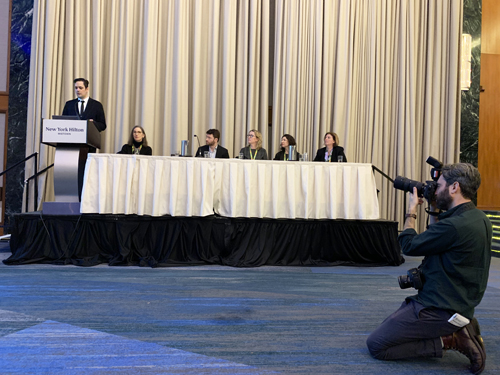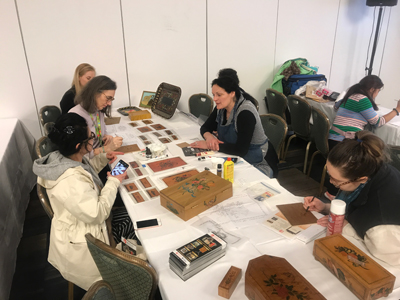Art Review: College Art Association 2019 New York
By Gail Levin © 2019
arttimesjournal March 16, 2019
 Art, Crime and History panel. Thiago Piwowarczyk, speaker and next to him Gail Levin |
The 107th annual conference of the College Art Association took place in New York City from February 13-16, 2019. As a long-time member and regular participant, this year I organized a session, "Art, Crime, and History." I was worried when we were assigned the New York Hilton's Grand Ballroom and the time slot at 10:30 to noon on the first day. How would we ever populate such a large space? Due to teaching responsibilities and wintry weather, some of my friends and colleagues could not even arrive in the city in time to attend. But I need not have worried since it appears that there is a growing international audience for this topic. Indeed, a hint had been the large number of potential speakers who responded to the call for papers.
One crime story with a happy ending was recounted by Olivia Miller, curator at the University of Arizona Museum of Art. She underlined the value of transparency regarding art theft, telling of how her museum recovered its stolen de Kooning after some thirty years because it had actively publicized the theft by holding its own symposium on art crime. The museum's painting had been cut from its stretchers and kept by the thieves until their deaths in old age. When an antique dealer bought the contents of the late couple's house and looked into the identity of the picture, he stumbled online upon the report of conference at the museum, which featured its own loss. The museum's openness and the dealer's honesty brought the painting home.
Art theft is nothing new. The torturous route and messy history of how Jan Van Eyck's well-known Arnolfini Portrait of 1434 reached the National Gallery in London in 1842 was retraced and questioned by Professor Alexandra Fried from the University of Gothenburg in Sweden, sponsored by a Samuel H. Kress Foundation CAA Conference Travel Fellowship for International Scholars.
 Art, Crime and History panel. Speaker is Alexandra Fried; (l to r) Gail Levin, Thiago Piwowarczyk, Stephen Mack; |
The checkered career of the New York artist and art dealer, Leo Nardus, who arrived from the Netherlands in the Guilded Age, was reconstructed by Esmée Quodbach, Assistant Director of the Frick Collection's Center for the History of Collecting. She told how Nardus sold both authentic and forged old masters to some of America's leading collectors, complicating the art market in America and especially the history of connoisseurship.
A more redemptive tale of forgeries of the Surrealist Yves Tanguy, produced by his beleaguered friends in occupied France during World War II was offered by Stephen Mack, of Rutgers University. At first the artists produced forgeries as a way to fund the Résistance by marketing the fake art to Germans, but from there they moved on to forging other artists and selling to other buyers, the legacy of which still causes attribution issues.
Provenance and the corruption of knowledge was the theme presented by Thiago Piwowarczyk, who is a partner at New York Forensics, a firm that provides scientific analysis of art objects for purposes of determining attribution and authenticity, as well as detecting fakes and forgeries.
I began the session began with a brief introduction, explaining how I became interested in art crime. While still in my twenties and beginning to work on the catalogue raisonné of Edward Hopper at the Whitney Museum, a man arrived at my office with a suitcase full of Hopper's boyhood work, claiming to be a family friend. It took some time before my research made clear that this man had stolen the works that he wanted me to authenticate by including them in the complete catalogue of Hopper's work. His possession of so many works puzzled me since Hopper's widow had willed all of her husband's art to the Whitney and she had not listed these works in the meticulous record books that she kept. When I shared these concerns with the museum, their response was to try to hush it up. I am still trying to understand how this thief got away with so much and why the Whitney not only concealed the theft but has actually honored the thief, who, it turns out, had purloined not just many artworks, but also all of Edward Hopper's papers (letters, notebooks, etc.), which he and his family sequestered for fifty years after Hopper's death.
A rapt audience and positive comments about the session that have kept coming have assured me that the time is right to deal with these issues. Our concern is not just art crime, but the way that crime distorts history and not just the history of art. What is driving all of this art crime is, of course, the immense inflation of prices in the art market.
"The Price of Everything," a revealing documentary film about the market for contemporary art was screened at the conference. Directed by Nathaniel Kahn, who made My Architect, about his father, Louis I. Kahn, this incisive and revealing film offers an opportunity to hear from artists, dealers, auction houses, and collectors. The film makes a striking contrast between the artist, Jeff Koons, who has achieved record-breaking financial success with works that he has fabricated by others, with Larry Poons, whose large handcrafted paintings still sell, but no longer at the stratospheric prices that might have been expected from his early success. One might conclude that the arbitrary nature of the art market comes across poignantly in this film.
 Glass Painting workshop offered by the Historical Society of Early Decoration, Cooperstown, NY |
Other CAA panels featured artists of all kinds and art historians speaking about a wide variety of art (American, Asian, European, Latin American, Pre-Columbian, Oceania, among others), identity politics, the environment and art, museums, and pedagogy. Many sessions running simultaneously meant that one had to pick and choose. I tend to follow a wide variety of topics. Among my favorites this year was a session called "Digital Art: New Dimensions," which featured artists such as Philip Galanter who spoke on "Artificial Intelligence! Artificial Art?" and Roz Dimon, who presented "Digital art: Toward A New Abstraction and Narrrative." In contrast to such contemporary media, there was also a workshop, which I attended, on the folk art technique of painting on the back of glass. Years ago, I wrote about such glass paintings made by Marsden Hartley, Vassily Kandinsky, and other modernists, who were drawn to folk art, but this was the first time that I got to try out the technique. I left the conference feeling that my time there was rewarding in many different ways.
Gail Levin writes artists' biographies, art history, and fiction; curates exhibitions; and exhibits her own art. A native of Atlanta, Georgia, Levin is now Distinguished Professor of Art History, American Studies, and Women's Studies at The Graduate Center and Baruch College of the City University of New York.
